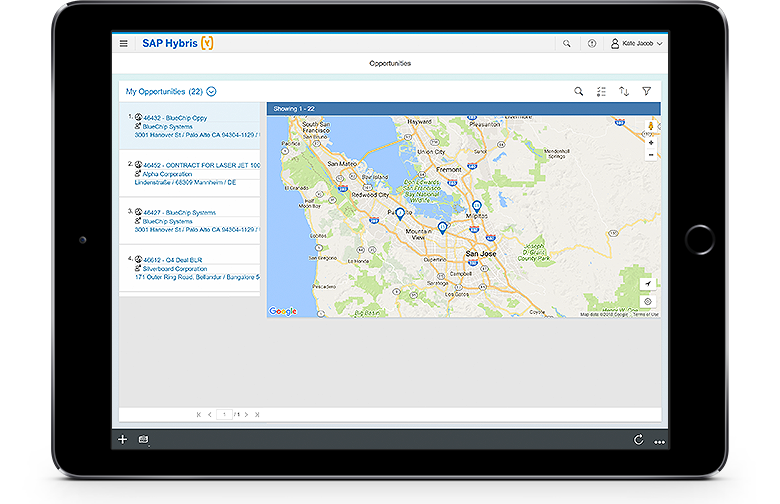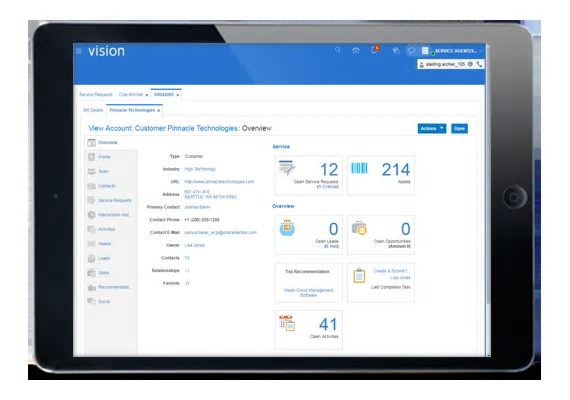The contest between Oracle and SAP involving their respective customer relationship management (CRM) applications in many ways is only one front in a battle between ERP titans that has been fiercely contested for decades. In fact, both companies are positioning their respective CRM applications as essentially the front end to ERP applications that collectively will drive a broad range of digital business transformation initiatives. In the case of SAP, that strategy is broadly referred to as the Intelligent Enterprise, while Oracle frames its CRM offering now within the context of the Oracle Engagement Cloud.
Oracle acquired Siebel, the pioneer of the category, in 2005. In the last two years, however Oracle has been especially focused on CRM applications integration. All Oracle applications now share a common database and application development framework. In the case of the CRM application that Oracle delivers via the cloud, that means customer records created in the CRM can also manifest themselves in, for example, the Oracle supply chain management application. Oracle contends this approach allows organizations to better manage a customer experience on an end to end basis because users of its CRM applications can avail themselves of visibility into the supply chain to better inform customers of where and when any order might be fulfilled.
SAP, meanwhile, has shifted its entire approach to CRM following the acquisition of hybrid in 2013. The company still supports its on-premises edition of its legacy CRM application, but SAP’s focus in clearly now on a SAP Sales Cloud offering that is delivered as a software-as-a-service (SaaS) application using primarily the Hybris code base running on an instance of the SAP HANA in-memory computing database. In fact, SAP Sales Cloud is just one element of a C/4 suite of customer experience applications that SAP is knitting together as set of integrated cloud application services. It’s not clear what percentage of the existing SAP base of CRM customers are making the move SAP Sales Cloud, but support for the SAP HANA database makes it possible to share customer records across multiple SAP applications.
It is worth noting that Oracle crafted an approach to CRM using the same code base on the cloud and in an on-premises IT environment as part of its hybrid cloud computing strategy that after much time and effort is starting to finally gain some traction.
What are the Similarities & Differences between Oracle Engagement Cloud and SAP Sales Cloud?
Both CRM applications are designed from the ground up to address the needs of larger enterprise. The most fundamental difference between each application is the underlying database they are each built one.
The Oracle Engagement Cloud is built on an Oracle relational database that is already widely employed across many IT environments. Oracle relies on that foundation to make it possible to deploy a suite of applications in the cloud or in an on-premises IT that all share access to a common pool of data.
SAP Sales Cloud is built on top of the SAP HANA in-memory database, a columnar database that has multimodal capabilities that allow to process relational transactions as well as geo-spatial data typically associated with locations in a CRM application. The SAP HANA database is not nearly as widely adopted as the Oracle database, but in organizations that have standardized on the SAP HANA database to run SAP ERP applications, SAP Sales Cloud becomes a more natural choice.
|
Criteria |
SAP Sales Cloud |
Oracle Customer Experience Cloud |
|
Cost |
Starts at $57 per user per month for an annual subscription |
Starts at $65 per user per month for an annual subscription |
|
Ease of Use (10%) |
4 |
4 |
|
Implementation (20%) |
4 |
5 |
|
Customization (20%) |
5 |
4 |
|
Integrations (20%) |
4 |
5 |
|
Customer Support (15%) |
5 |
5 |
|
Features & Add-ons (15%) |
4 |
4 |
|
Total Rating |
X |
X |
Cost
SAP Pricing
SAP on its app store publishes an entry list price of $57 per user per month for an annual contract,.
Oracle Pricing
Oracle quotes an entry level cost of $65 per user per month for an annual contract
Both companies offer richer variations of their applications that cost considerably more.
In truth, however, both companies can be expected to be very aggressive on pricing, especially in scenarios where CRM software and services are being bundled with ERP applications.
Ease of Use
SAP User Interface
SAP touts the fact that SAP Sales Cloud is one of the first applications the company has developed with a mobile-first philosophy. The effort represents substantial progress for SAP.
Oracle User Interface
Oracle Engagement Cloud is similarly a SaaS application that has been optimized for mobile computing experiences.
SAP, however, appears to be further along when it comes to inject artificial intelligence (AI) into its applications as part of broad effort to embed machine learning algorithms across its portfolio. Oracle, however, is likely to make up most of the ground before digital assistants truly become ubiquitous.
Implementation
SAP Sales Cloud as one of the primary applications that SAP is relying in to makes a transition to the cloud relies on a similar SaaS-based approach.
Similarly, Oracle makes its CRM software available as a SaaS application. However, organizations also have the option of deploying Oracle CRM software on-premises using the same underlying database platform. That, however, does represent a more complex deployment endeavor.
While both Oracle Customer Experience and SAP Sales Cloud are delivered as a SaaS application, organizations will find that there is a significant gap between merely activating a software license and being able to effectively employ Salesforce to manage a sales process. That work often requires either hiring someone with a lot of Salesforce expertise or relying on a third-party service provider.
Customization
SAP allows organizations to customize SAP Sales Cloud to a degree and as far as low-code tools relies on a reseller agreement with Mendix, a provider of a third-party low-code application development platform that is a unit of Siemens.
Oracle makes a wide range of tools available for building custom applications, but in the case of Oracle Engagement Cloud much of the customization effort is focused squarely on Oracle Application Composer, a browser-based tool that Oracle makes accessible to allow developers and business analysts alike to customize SaaS applications by linking objects and files.
The Mendix platform made available by SAP presents a more visually-oriented programming model that is both a little more accessible and powerful in terms of the type of custom applications that can be built.
Integrations
Oracle’s applications all tie into a common set of integration and platform-as-a-service (PaaS) environment managed by Oracle on behalf of the end customer.
SAP, meanwhile, as part for the SAP C/4 suite of cloud services makes available SAP Hybris Cloud for Customer Element, a separate turnkey cloud service for API integration as well as SAP Cloud, an instance of the open source platform-as-a-service (PaaS) environment developed under the auspices of the Cloud Foundry Foundation.
It also worth noting that SAP Sales Cloud can also be integrated with the Sap Hybrid e-commerce platform that share much of the same code base and that SAP has pledged to lower the cost of integration by making available hundreds of turnkey modules for specific use cases that promise to lower the total cost of integration.
Customer Support
SAP and Oracle both provide an extensive array of support options for their proprietary software. In fact, while it’s possible to run SaaS applications without contracting for that support it wouldn’t be advisable.
Features & Add-ons
Neither Oracle nor SAP can definitively claim to have one killer CRM capability that the other does not support. It’s really a question of degrees. Both companies have also committed to rolling out new features and capabilities in their respective cloud offerings at a regular cadence.
Both companies are also building cloud marketplaces where any number of complementary third-party applications can be accessed. However, both companies have a reputation for adding features to their applications that suddenly render the role of a third-party tool or application suddenly redundant, so organizations should consider carefully what’s an actual extension versus a feature of the application that has yet to be delivered.
Related CRM Comparison Articles
How to decide which is Best for Your Situation
Much of the decision to go with Oracle or SAP for a CRM application will be influenced by how heavily any organization is dependent on ERP applications provided by either vendor.
Another factor is to what degree an organization believes that an in-memory database in the form of SAP HANA will provide strategic benefits that are not available in an Oracle relational database.
Where Oracle does have a clear advantage is in the realm of hybrid cloud computing. In organizations where applications need to be able to run both in the cloud and in an on-premises environment, Oracle has some clear advantages.
However, the number of organizations that need to specifically run a CRM application in an on-premises IT environment may be starting to dwindle.
Arguably, the real issue is to what degree CRM going forward is a standalone application purchased mainly by sales teams or is really a front interface through which a complex set of digital business processes running on backend ERP applications become more accessible. In the latter case, it’s arguable that CRM applications themselves are about to become a feature of much larger digital business platform that is still evolving.




